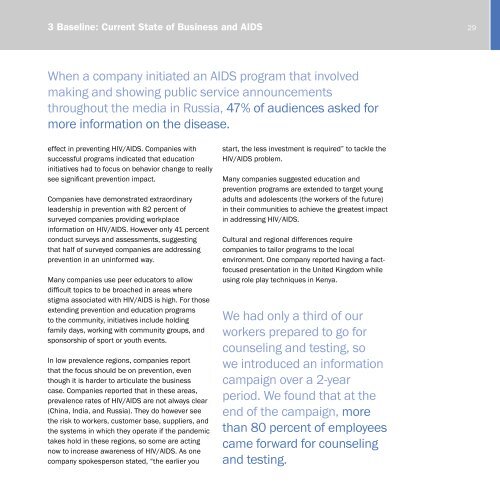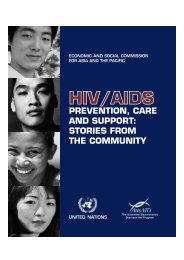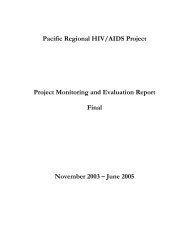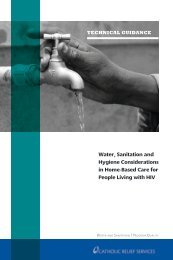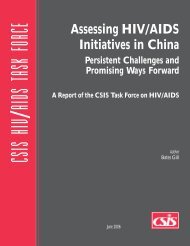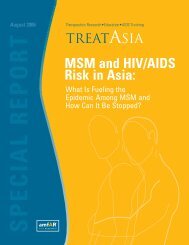The State of Business and HIV/AIDS (2006) - Booz Allen Hamilton
The State of Business and HIV/AIDS (2006) - Booz Allen Hamilton
The State of Business and HIV/AIDS (2006) - Booz Allen Hamilton
You also want an ePaper? Increase the reach of your titles
YUMPU automatically turns print PDFs into web optimized ePapers that Google loves.
3 Baseline: Current <strong>State</strong> <strong>of</strong> <strong>Business</strong> <strong>and</strong> <strong>AIDS</strong><br />
29<br />
When a company initiated an <strong>AIDS</strong> program that involved<br />
making <strong>and</strong> showing public service announcements<br />
throughout the media in Russia, 47% <strong>of</strong> audiences asked for<br />
more information on the disease.<br />
effect in preventing <strong>HIV</strong>/<strong>AIDS</strong>. Companies with<br />
successful programs indicated that education<br />
initiatives had to focus on behavior change to really<br />
see significant prevention impact.<br />
Companies have demonstrated extraordinary<br />
leadership in prevention with 82 percent <strong>of</strong><br />
surveyed companies providing workplace<br />
information on <strong>HIV</strong>/<strong>AIDS</strong>. However only 41 percent<br />
conduct surveys <strong>and</strong> assessments, suggesting<br />
that half <strong>of</strong> surveyed companies are addressing<br />
prevention in an uninformed way.<br />
Many companies use peer educators to allow<br />
difficult topics to be broached in areas where<br />
stigma associated with <strong>HIV</strong>/<strong>AIDS</strong> is high. For those<br />
extending prevention <strong>and</strong> education programs<br />
to the community, initiatives include holding<br />
family days, working with community groups, <strong>and</strong><br />
sponsorship <strong>of</strong> sport or youth events.<br />
In low prevalence regions, companies report<br />
that the focus should be on prevention, even<br />
though it is harder to articulate the business<br />
case. Companies reported that in these areas,<br />
prevalence rates <strong>of</strong> <strong>HIV</strong>/<strong>AIDS</strong> are not always clear<br />
(China, India, <strong>and</strong> Russia). <strong>The</strong>y do however see<br />
the risk to workers, customer base, suppliers, <strong>and</strong><br />
the systems in which they operate if the p<strong>and</strong>emic<br />
takes hold in these regions, so some are acting<br />
now to increase awareness <strong>of</strong> <strong>HIV</strong>/<strong>AIDS</strong>. As one<br />
company spokesperson stated, “the earlier you<br />
start, the less investment is required” to tackle the<br />
<strong>HIV</strong>/<strong>AIDS</strong> problem.<br />
Many companies suggested education <strong>and</strong><br />
prevention programs are extended to target young<br />
adults <strong>and</strong> adolescents (the workers <strong>of</strong> the future)<br />
in their communities to achieve the greatest impact<br />
in addressing <strong>HIV</strong>/<strong>AIDS</strong>.<br />
Cultural <strong>and</strong> regional differences require<br />
companies to tailor programs to the local<br />
environment. One company reported having a factfocused<br />
presentation in the United Kingdom while<br />
using role play techniques in Kenya.<br />
We had only a third <strong>of</strong> our<br />
workers prepared to go for<br />
counseling <strong>and</strong> testing, so<br />
we introduced an information<br />
campaign over a 2-year<br />
period. We found that at the<br />
end <strong>of</strong> the campaign, more<br />
than 80 percent <strong>of</strong> employees<br />
came forward for counseling<br />
<strong>and</strong> testing.


